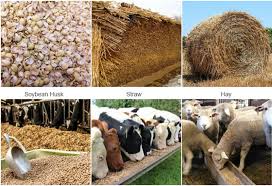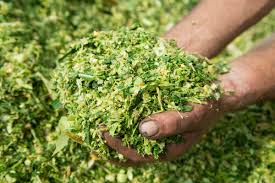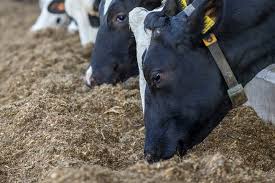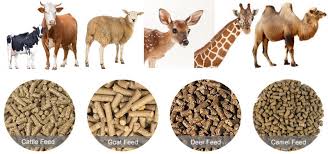In this article, various types of feed materials available in the environment for feeding ruminant animals will be discussed, as mentioned in an earlier article on the digestive abilities of ruminants.
Adequate nutrition is essential for the optimal growth and development of animals. Although ruminants can survive on forage, it does not contain enough nutrients to meet their needs for growth and production. Therefore, their feed should be supplemented.
Definition of Key Terms
Certain key terms are commonly used when discussing feeds and feeding materials.
1. Feed: Feed is a mixture of feedstuffs blended or processed in a form that is acceptable to livestock. It refers to material that, after ingestion, can be digested, absorbed, and utilized by the body for maintenance, growth, or production.
2. Nutrient: A nutrient is any food constituent or group of constituents of the same general chemical composition that aids in sustaining the body. Examples include proteins, carbohydrates, water, fats/oils, minerals, and vitamins.
3. Ration: A ration is a fixed amount of feed allocated to an animal over a 24-hour period.
4. Diet: A diet is a combination of various ingredients in the right proportion to meet the nutritional requirements of the animal.
Read Also: Introduction to Fishing Gear Technology
Classification of Feedstuffs

Feedstuffs are plant and animal tissues containing nutrients for livestock. They are grouped into different classes based on botanical origin and chemical composition.
1. Roughages
These are bulky feed materials with low weight per unit volume, containing more than 18% crude fiber. They are low in energy and protein, with a high content of cell-wall material. Roughages range from highly nutritious (lush young grass, high-quality silage) to poor-quality feeds (straw, hay, stover, chaff, browse).
2. Green (Fresh) Plants
- Pasture – Fresh green grasses cut and taken to animals
- Crop residues – Plants that remain green after maturity.
3. Silage

- Corn (maize)
- Sorghum
4. Dry Plant Material
- Hay – Grass or legume harvested while still young and dried.
- Straw – Mature, dried plant material cut after ripening.
- Crop by-products – Includes maize stalks, groundnut shells, etc.
5. Concentrate Feeds
Concentrates are feed materials with low moisture and fiber content, relatively high in digestible nutrients.
i. Protein Concentrates
These concentrates contain more than 20% crude protein and may be of plant or animal origin. Examples include fish meal, blood meal, meat meal, milk powder, and plant-based concentrates like groundnut cake, sunflower meal, and coconut meal.
ii. Energy Concentrates
This category includes cereal grains, roots, tubers, and fruits, which are rich in carbohydrates. Examples include maize, guinea corn (sorghum), cassava, and potatoes.
Non-Protein Nitrogen Compounds as Protein Source
Non-protein nitrogen compounds, such as urea and poultry waste, serve as nitrogen sources for ruminants due to the ability of rumen microbes to synthesize their unicellular tissues.
Mineral and Vitamin Supplements
Mineral supplements, such as bone meal, rock phosphate, and oyster shells, are essential for livestock diets. Vitamins, however, are usually synthesized by rumen microorganisms, reducing the need for supplementation.
Read Also: Introduction to Fish Nutrition
Characteristics of Feedstuffs

1. Protein Sources
Common protein sources in livestock feeding include:
i. Soya Bean Meal: A by-product of soya bean oil, soya bean meal is widely used as a protein supplement with a crude protein content of 44-48%.
ii. Groundnut Cake: A major protein source in livestock feed, particularly in northern Nigeria, with a protein value of 45-47%.
iii. Cotton Seed Cake: A by-product of cotton seed oil production, cotton seed cake is a cheaper protein source compared to soya bean meal and groundnut cake.
iv. Palm Kernel Cake (PKC): PKC contains about 20% protein. Other protein sources include sunflower meal, blood meal, fish meal, and meat and bone meal.
2. Energy Sources
Key carbohydrate sources for energy are discussed below.
i. Maize: Maize is the primary energy source for livestock, providing the highest metabolizable energy (ME) of all cereal grains, at 3442 ME Kcal/kg.
ii. Sorghum (Guinea Corn): Sorghum is less palatable than maize and has a lower metabolizable energy content.
iii. Millet: A common grain in arid regions where maize and sorghum do not thrive.
iv. Wheat Offal: By-products from wheat milling, including wheat germ and bran, which are low in energy but rich in phosphorus and B vitamins.
Other energy sources include cassava, molasses, rice bran, fats and oils, and oil seed sludge.
In conclusion, a variety of feed materials are available for ruminants, and the choice depends on availability and cost. Farmers are encouraged to use locally available materials that are more affordable.
Roughages are provided to ruminants freely, while concentrates are offered as supplements, either in the form of protein, energy, or a combination of both.
Do you have any questions, suggestions, or contributions? If so, please feel free to use the comment box below to share your thoughts. We also encourage you to kindly share this information with others who might benefit from it. Since we can’t reach everyone at once, we truly appreciate your help in spreading the word. Thank you so much for your support and for sharing!
Read Also: Impact of Agricultural Wastes on Human and Environment
Frequently Asked Questions
We will update this section soon.

